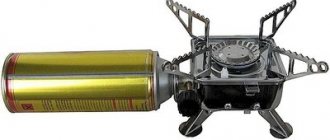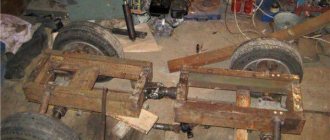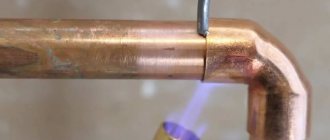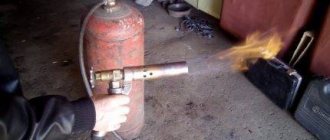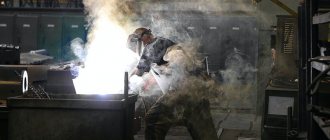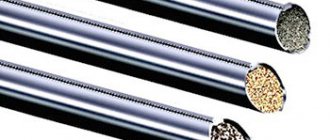1 / 1
For welding metals, the welding torch plays an important role along with the machine itself. The quality of the final result, the safety of the process and the level of productivity directly depend on it.
A semi-automatic torch is usually supplied complete with a welding machine. A good manufacturer immediately selects the best option. But this is a consumable that periodically wears out and requires replacement. Choosing a new one is complicated by a large number of nuances, which can be difficult to understand.
Why do you need a welding torch?
You can do without a torch unless you perform manual arc welding (MMA). In other cases, it is the welder’s main tool. It is used in all types of welding processes where gas is required:
- MIG/MAG (in a protective gas environment);
- TIG (argon arc);
- point method;
- gas welding;
- plasma cutting.
Its main purpose is to mix and supply protective or combustible gas to the working area, forming a stable flame. In this case, the combustion strength can be adjusted.
Understanding the device
Welding torches for each type of welding may have design features unique to them. But in general their device is identical: the burner itself (gander)
,
sleeve (train)
and
contact element
.
The gas welding tool is designed as simply as possible. On the back of the handle there are two fittings to which hoses are connected. The supply of gases is regulated by valves. There is a mixing chamber inside. The tip is attached to the handle by means of a union nut. And the design is completed by a mouthpiece through which the flame comes out.
A torch for a semi-automatic welding machine is distinguished by the fact that in addition to gas, current and welding wire are also supplied to it through a loop. Powerful devices have channels for liquid cooling.
For semi-automatic machines
As a rule, welding torches for semi-automatic machines are selected based on their operating parameters, such as the magnitude of the welding current, the type of cooling system and the configuration of the docking connector. However, for any version of the product, the length of the supply hose should be in the range from 3 to 5 meters (depending on the tasks being solved).
As for cooling the welding torch itself, it can be water (liquid) or air. The first of these options is in demand when welding long seams, regardless of the current strength in the circuit.
Air-cooled torches are used to work with relatively short seams (at currents up to 350 Amperes). The correct choice of welding tool for electric welding (for semi-automatic welding, in particular) can significantly increase work productivity and reduce the level of physical fatigue.
At the same time, when handling a high-quality and convenient welding torch, the likelihood of an accidental work injury is reduced.
Working principle of a welding torch
This equipment has a simple principle of operation: gases are supplied to the mixer through control valves, after which they exit under pressure through a nozzle. The burning gas flow must have a certain speed - 70-150 m/sec. Exceeding this value causes the flame to break away from the mouthpiece and die out. And if the gas speed is too low, the fire can spread inside the instrument, which can lead to an explosion. Therefore, it is important that combustion occurs in specified modes.
In devices such as MIG/MAG or TIG, the process of seam formation occurs not under the temperature influence of a flame, but through an electric arc. But gas is also present and serves to form a protective environment around the weld pool.
Soldering technology
The area to be soldered must first be cleaned of dirt, rust, dirt and degreased. After preliminary preparation, the products are thoroughly dried and coated with flux. The parts to be soldered must be fixed so that the solderer has both hands free, since he will need to hold the torch and solder while working.
Then the product is heated so that the material is heated evenly along the entire length of the joint. To do this, the torch is continuously moved along the seam.
Pay attention to the burner flame. A properly adjusted flame has a dark core, middle part and edges with clear contours. If excess oxygen is supplied, the flame becomes sharply shorter, and if a lot of combustible gas is supplied, the middle zone disappears, the length of the flame increases, loses clarity, and the fire begins to smoke.
The highest temperature is at the end of the core, so preheating is best done with the outer part of the flame. After the soldering seam is heated to the melting temperature of the solder used, the end of a solder rod coated with flux is applied to the seam, which, when melted, closes the seam.
To avoid burnout, the solder must be heated quickly with a neutral, not very hot, flame. After soldering is completed, it is better not to touch the parts until the solder has completely hardened, so as not to displace the workpieces.
Classification of welding torches
A properly selected welding torch allows you to perform metal welding as efficiently as possible and ensures the comfort and safety of the worker. To buy a tool specifically for your needs, you need to know its classification and design features. The external simplicity of these products is deceptive; If you dig deeper, an unprepared person may feel dizzy from the diversity of their species:
- With and without injector.
- Gas and liquid.
- Universal and specialized.
- Single-flame and multi-flame.
- Manual and machine.
- With different flame power.
In addition, for each type of welding (semi-automatic or manual feed of filler rod, MIG/MAG or TIG, gas welding) a device of a certain design is required. Therefore, before you go shopping, it is useful to familiarize yourself with the classification of equipment.
Gas-burners
According to the principle of operation, torches for gas welding are either injection or non-injector (diffusion), and also differ in the gas used and in power.
Power characteristics
The capabilities of a gas burner and its scope of application largely depend on its power. This indicator is regulated by GOST 1077-79, according to which equipment is divided into 4 types:
- Micropower (r1) – non-injector type burners with a fitting size M12x1.25. Used for welding metal with a thickness of 0.1 to 1 mm, as well as for soldering.
- Low power (r2) – injection and non-injector type burners with replaceable fittings (the most popular tips are sizes M12x1.25 and M16x1.5). This is a common option, well suited for home use and small workshops. The thickness of the welded products is from 0.3 to 10 mm.
- Average power (r3) – here it is also possible to use injection and non-injector mechanisms. Tip size M16x1.5. They cook metal with a thickness of 0.5-35 mm. Most often used in industrial settings.
- High power (r4) – only injection type burners with M16x1.5 fitting. Weld thick-walled structures from 40 to 85 mm.
Injectorless burners
Diffusion models are extremely simple in design. Oxygen and combustible gas are supplied to the mixing chamber with the same pressure through separate channels. Before entering the mixer, the flows are divided into several thin jets. This creates extra swirls and promotes better mixing. The resulting mixture rushes further and comes out of the tip.
Injectorless burners have their advantages: you can separately regulate the supply of each component, accurately changing the flame temperature at the outlet; high pressure is not required for operation. The disadvantages include incomplete combustion of gas and low efficiency, the risk of flame entering the nozzle with subsequent explosion of the holder.
Injection
In injection models, only oxygen pressure can be adjusted. It is fed into the mixing chamber at high speed past the openings for the entry of flammable gas. This creates a rarefied low-pressure zone, under the influence of which the flammable gas rushes into the mixer after the oxygen. And then the mixture comes out along the tip. Thanks to this, the components are mixed thoroughly, and combustion occurs at a higher temperature. The flame escapes from the nozzle at a higher speed, which prevents it from entering. The disadvantage is uneven combustion, due to the fact that it is impossible to accurately adjust the ratio of components.
Differences in gas used
Three different types of gas mixture can be used in the welding process. Each of them requires its own burner:
1. For acetylene welding. The main application is welding, soldering and heating of metals. Flame temperature is about 3200 °C. You can weld ferrous metals of small thickness. Working with high-quality alloy steel is also possible, but the quality will be low.
2. Propane-oxygen. Due to the low combustion temperature of propane (2000-2100 °C), it is difficult to cook ferrous metal with them, but it is possible if the material thickness is up to 3 mm and the quality of the connection does not matter. These torches are better suited for soldering using high-temperature solder.
3. For gas-air propane welding. These are injection-type burners for working with a propane-butane mixture. You won't be able to cook or solder with them. The main purpose is to heat non-metallic and metallic materials. For example, when laying a roof or heating pipes for their subsequent bending. They are divided into single-flame and multi-flame (with several nozzles).
Semi-automatic torches (MIG/MAG)
The MIG/MAG welding process is carried out with a fusible electrode in a shielding gas environment. The torch consists of three main elements: the working part - the gooseneck, the cable and the contact connector, which is used to connect to the welding machine. Wire, gas and electric current are supplied through the hose to the working part. The gander is shaped like a pistol with an activation button.
When choosing a torch for semi-automatic welding, a number of factors should be taken into account: amperage, hose length, type of cooling, ergonomics and ease of maintenance.
With the first parameter, everything is very clear; it is only important to know what maximum current your welding machine is designed for, and choose equipment in accordance with this indicator.
The length of the sleeve is selected based on your own preferences and objectives. Some people believe that an excessively long cable contributes to energy loss, preferring short ones. For others, on the contrary, the length margin is important for greater mobility.
The type of cooling can be air or liquid. The first is suitable for welding with low currents (up to 250 A). With more powerful welding machines, liquid cooling is preferable.
Everyone chooses ergonomics for themselves. It is important that the instrument fits comfortably in your hand and is well balanced.
The main load falls on the working edge of the burner. For ease of maintenance, the tip with nozzle and diffuser are removable. This makes it possible to work with wires of different thicknesses, making them easier to clean or replace.
For argon arc welding (TIG)
Argon welding also takes place in a shielding gas environment, but a refractory electrode is used, and the formation of the seam occurs due to the filler material. There is no need for a device for supplying the electrode; it is fixedly fixed in the center of the nozzle. The factors you should pay attention to when choosing are the same as in the case of a semi-automatic. In addition, there are valve TIG torches that allow you to control the gas supply. It is convenient if the torch for argon arc welding is equipped with a trigger, with which you can activate the gas supply at the required moment.
How to choose a gas soldering iron
Before purchasing a tool, pay attention to its operating parameters. The following three characteristics are important for gas soldering irons.
Temperature is the maximum to which the soldering iron surface can be heated. If you purchase a gas soldering iron for hobby or home use, then 1000-1500 °C will be enough to work with soft solders (bronze, copper, silver, gold). Often such soldering irons, for example, the Kemper 10500 model, are used in the jewelry business to restore jewelry. For professional use, a temperature of about 2000 °C is needed, like the BernzOmatic JT 539 T-E TURBO 19190, so that hard solders can be melted.
The presence of a flame level regulator - if the regulator is provided in the design of the soldering iron, then this allows you to more accurately set the temperature for working with different materials and solders. The regulator is especially useful if you will be removing old coatings or welding parts.
Flame type. Pencil - a very narrow concentrated flame stream, intended for precision work, mainly jewelry. An example is the Kemper 10500 soldering iron. The “jumbo” type flame is also a narrow flow (but wider than a pencil flame), like the BernzOmatic JT 680 model. A vortex flame is suitable for cases where you need to heat large surface areas of parts to the desired temperature. There is also a multi-purpose flame, like the Dremel VersaTip F0132000KB model. It is designed to perform a large number of different operations (welding, heat shrinking, heating, soldering, burning, etc.), where it is not necessary to heat the parts to high temperatures.
Rules for using welding torches
The first step is to clean the welded areas to ensure a better connection and select the appropriate filler wire. Next, the current strength and wire feed speed are pre-regulated on the welding machine. Afterwards the speed of the gas mixture is adjusted. This parameter is selected empirically or by selecting the built-in program. Now you can proceed directly to welding.
The torch and filler wire are directed to the beginning of the weld. As the weld pool forms, the torch moves forward. When making vertical seams, choose the direction from bottom to top. This will make it easier to control the process, and the surface after hardening will be less deformed. In this case, the gas supply should be approximately 30% higher compared to the horizontal process.
Important nuances
Working with gas requires a highly qualified welder, knowledge and compliance with safety rules. There are many nuances in the use of gas burners, here are the most important of them:
1. To start work, flammable gas is started first and only then oxygen. To extinguish the burner, it is the other way around: first, the oxygen is shut off, and then the flammable gas.
2. Gas burners are 2-stroke and 4-stroke. In the first case, to activate, you need to press and hold the start key. If you let go, the work stops. The operating principle of a 4-stroke torch is different: a short press of the button turns on the gas supply and activates the welding process; when pressed again, the gas stops flowing.
3. The diameter of the wire in the semi-automatic torch must exactly match the diameter of its guide inside the nozzle.
Pros and cons of piezo modifications
For amateurs who periodically carry out welding work, it is convenient to use a gas torch with piezo ignition. It is a can of gas with a nozzle installed on its neck .
The portable welding machine is adjusted by the gas mixture supply screw. Simply press the button and the piezoelectric element produces a spark, igniting the torch. You can work in any conditions, except for cold temperatures below – 20⁰, when the liquefied gas in the cylinder begins to freeze.
The disadvantages of small burners with piezo ignition are their small volume and disposal . The cylinder and nozzle are a one-piece, disposable device. When the gas runs out, the equipment has to be thrown away, having previously vented the remaining gas so that an accident does not occur.
The piezoelectric element for igniting the torch is used on gas nozzles for argon arc and TIG welding. When you press the button, a spark appears, igniting the gas.
Right choice
Any work using gas is classified as dangerous. Therefore, it is very important to be careful when choosing gas welding equipment. Never neglect safety rules and choose equipment only from trusted manufacturers.
has won special respect among professional welders, thanks to the characteristics and quality of its products. Only durable materials that meet all modern requirements are used in production. On the website you can order welding torches and all related components at prices from the manufacturer. Delivery is possible not only for residents of the capital, but also for all regions of Russia.
The company's product catalog includes torches for semi-automatic machines, as well as for argon-arc welding, that meet the highest safety parameters. Qualified managers know all the nuances of working with welding equipment and are always ready to make sure that your purchase is as useful as possible.
What gas can be used
Acetylene, hydrogen, and substitute gases (natural gas, propane-butane) can be used as combustible materials for a gas burner. Some designs operate on liquid flammable substances and waste oil.
The combustible substance enters the acetylene burner from the generator apparatus, where calcium carbide decomposes into slaked lime and acetylene. The gas for the burner has a pressure of 100-150 mmHg. Nitrogen obtained from atmospheric air is used as a shielding gas, which prevents the formation of scale, and water is used as a catalyst for the decomposition of carbide.
The hydrogen torch is the most popular among similar equipment designed for gas-flame processing. It is important that when using it, only water vapor is released, so it is the safest. When an aqueous alkali solution decomposes, hydrogen burns, followed by the release of energy, which is needed to speed up welding. Hydrogen protects the weld from exposure to oxygen, thereby preventing oxidation of surfaces.
Many owners have an idea of how a liquid fuel gas burner works, since the operation of a kerosene stove is based on this principle. When heated in a special coil, the flammable liquid turns into gas and due to this, significant savings are achieved during subsequent combustion. As a rule, kerosene and Galosha gasoline are used as liquid fuel.
Knowing how to use a gas burner during mining, or a Babington burner, you can significantly save on consumables and reduce the cost of work. Such designs use motor, compressor, and any vegetable oil as fuel. The fuel enters a spherical part, from which it is blown off by a stream of compressed air. The resulting small droplets then ignite.

